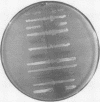Abstract
A method of typing Pseudomonas pyocyanea is described which makes use of the property of bacteriocine production. The method was applied in an epidemiological study of Ps. pyocyanea infection in a general hospital. It was found that the majority of strains believed on epidemiological grounds to be of common origin were allotted to the same pyocine type.
In the course of this study, Ps. pyocyanea was isolated from 219 patients; 474 strains from 149 of these were typed. There was evidence of cross-infection among patients in a urogenital surgical ward, but in other parts of the hospital there appeared to be little cross-infection. A number of individual instances of auto-infection, possibly arising from the bowel flora, were seen.
Full text
PDF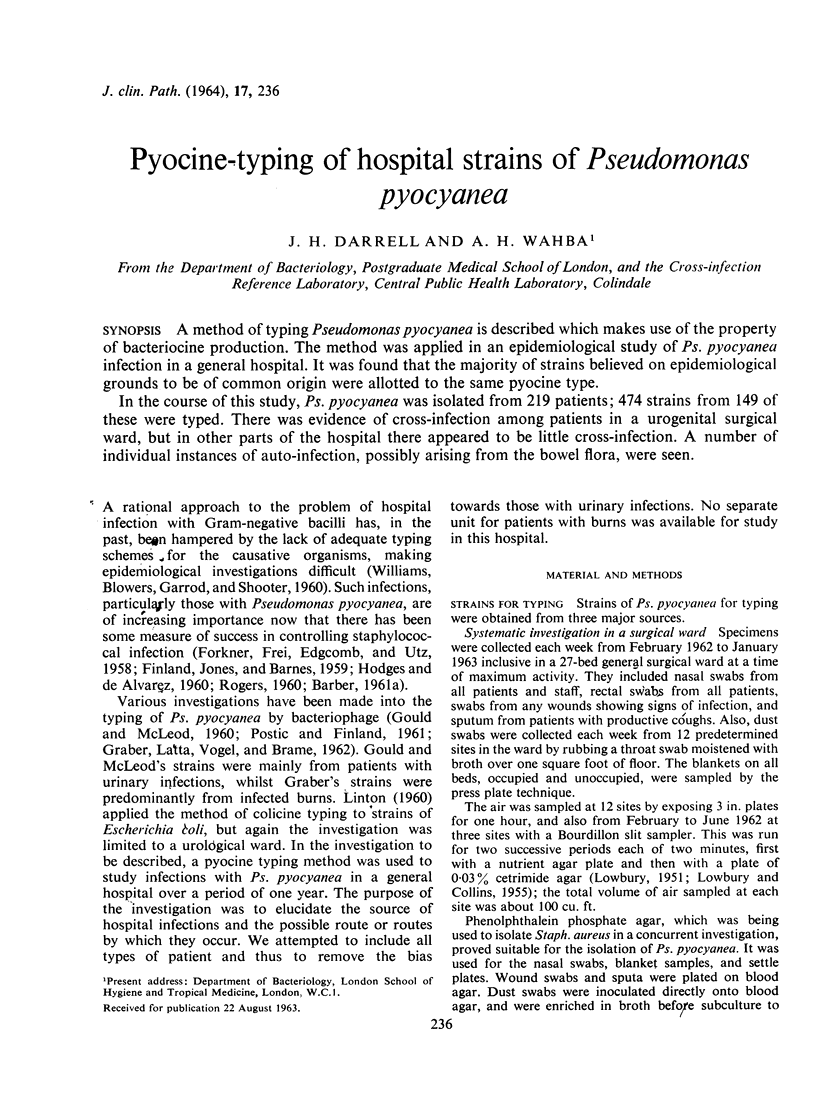
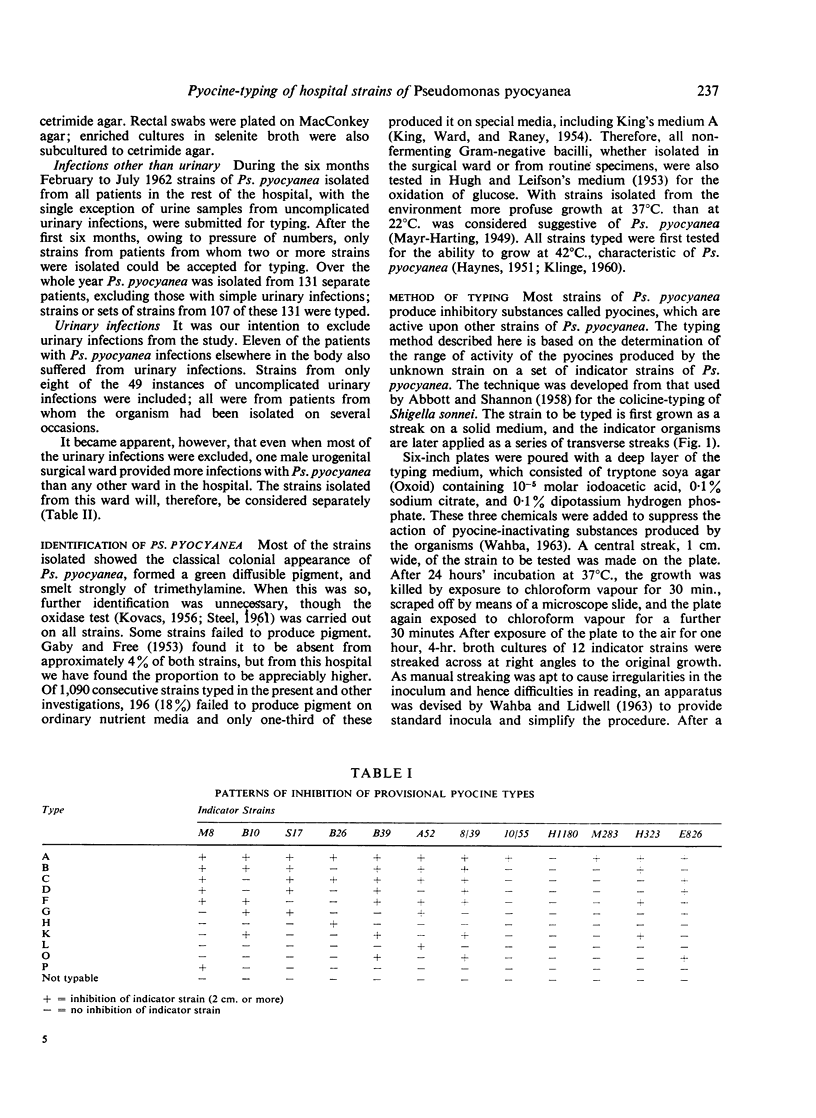
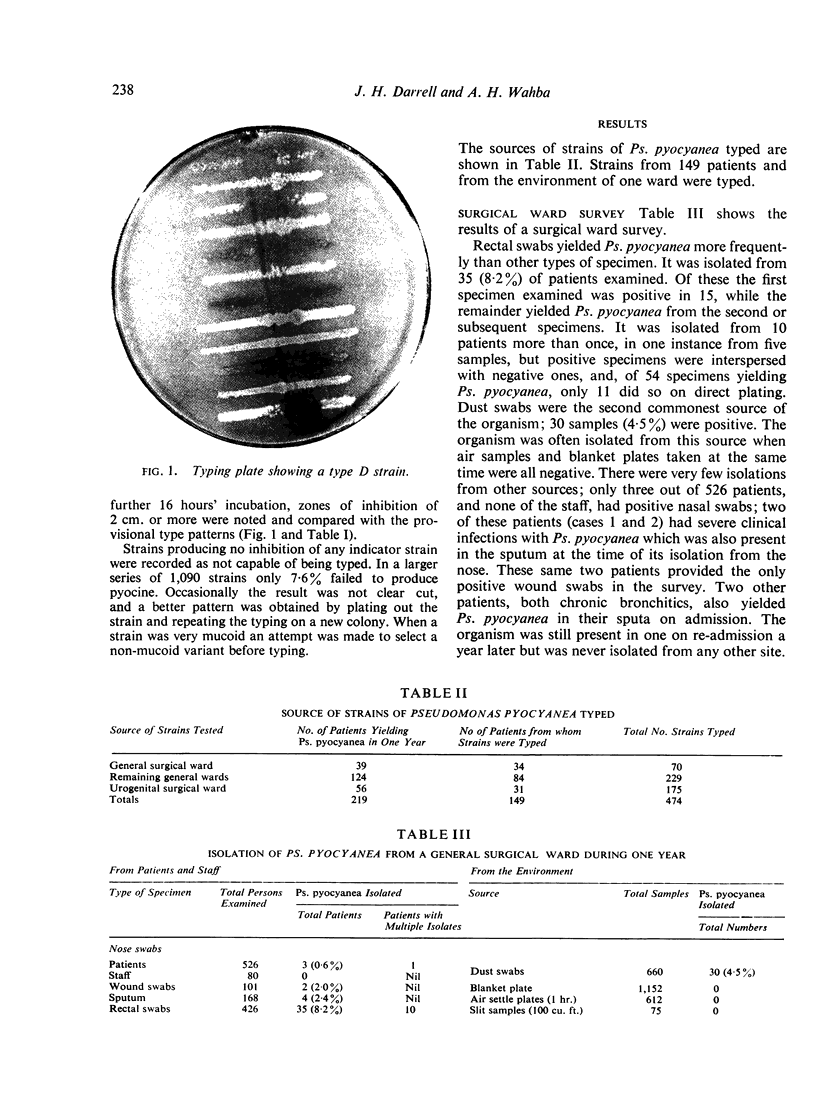
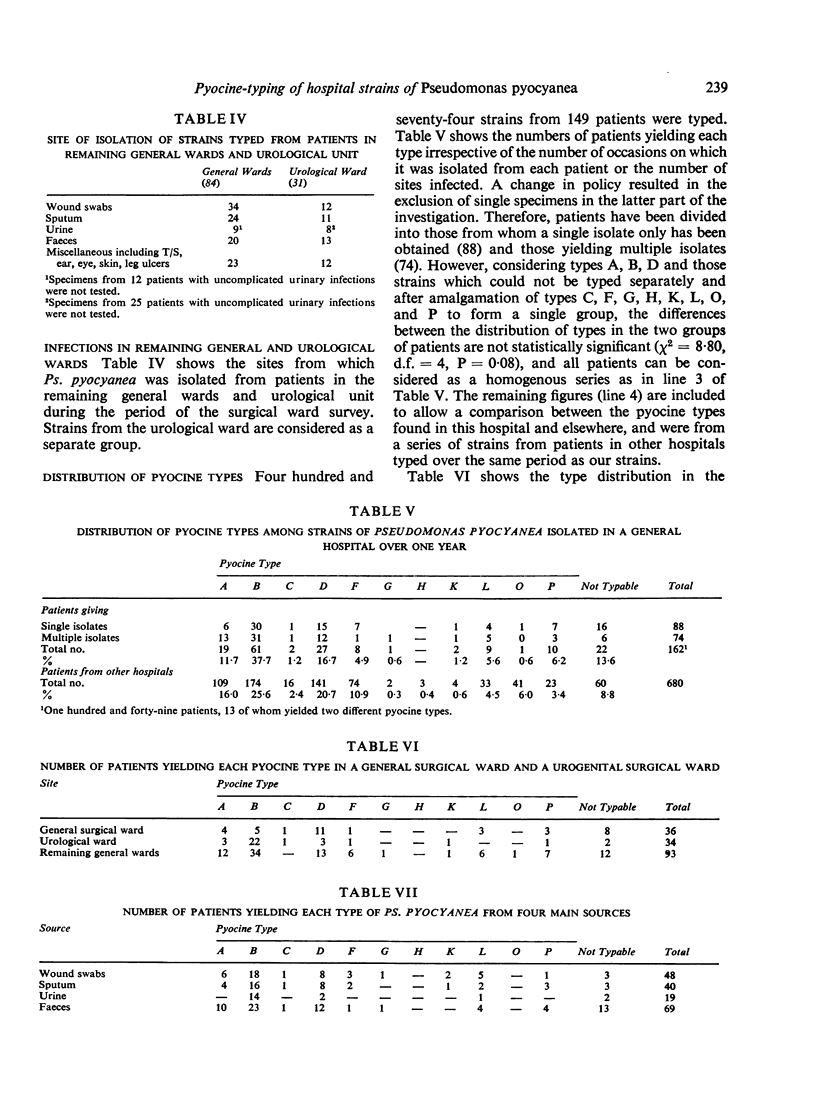
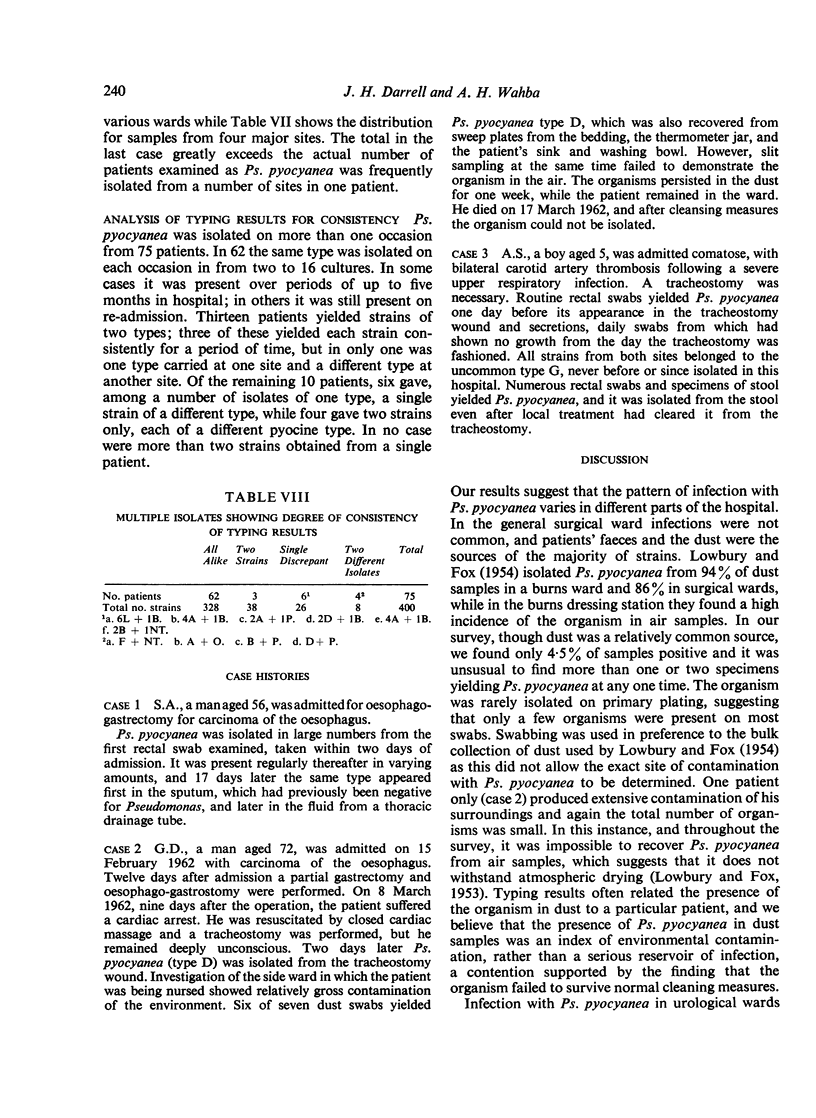
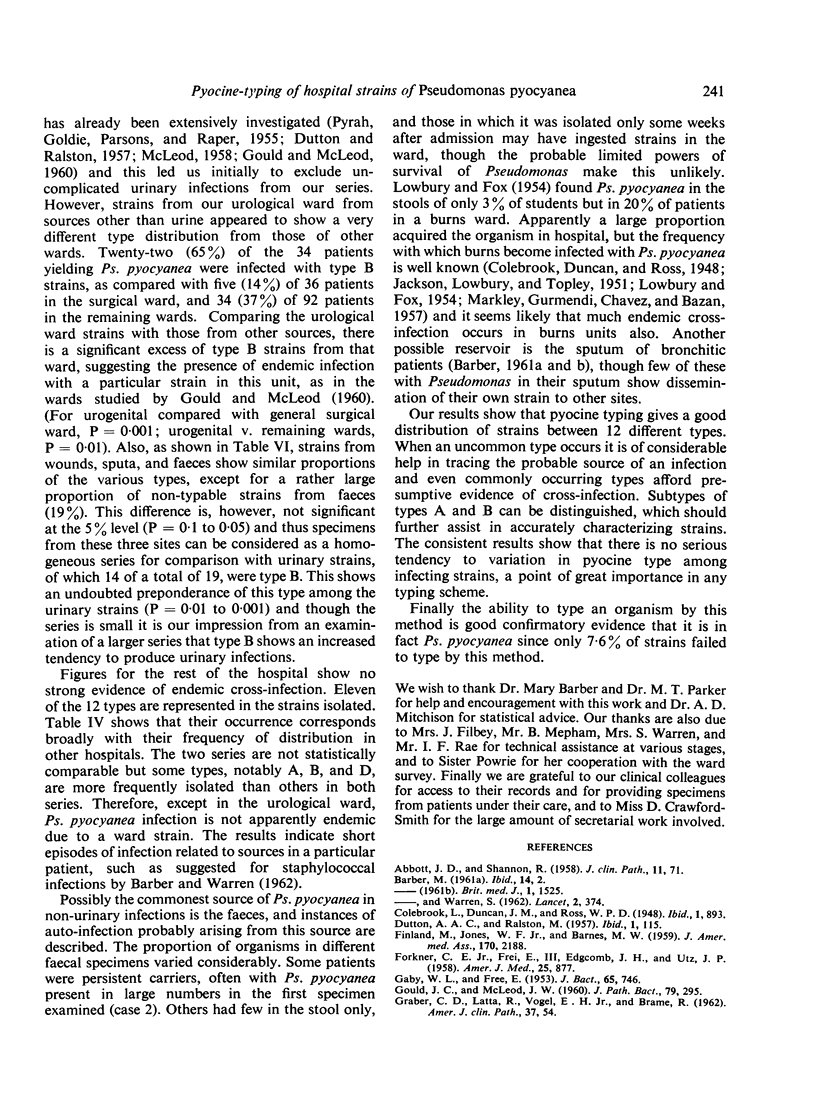
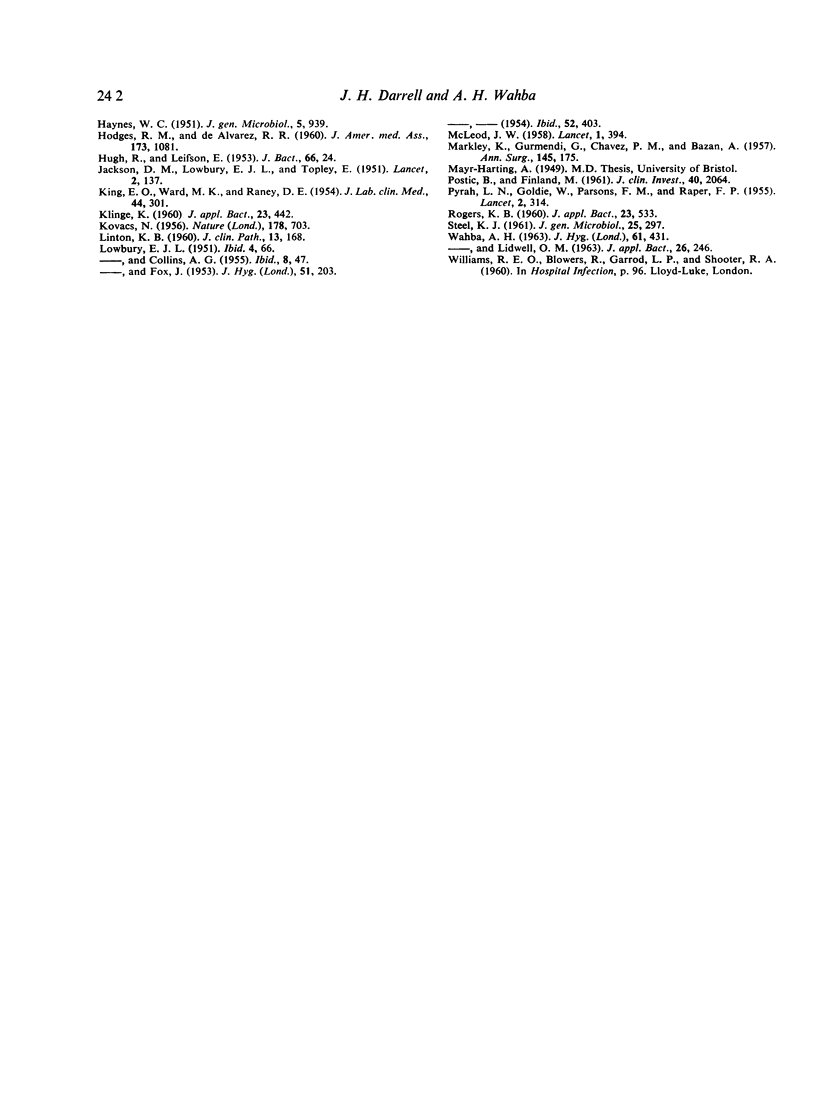
Images in this article
Selected References
These references are in PubMed. This may not be the complete list of references from this article.
- ABBOTT J. D., SHANNON R. A method for typing Shigella sonnei, using colicine production as a marker. J Clin Pathol. 1958 Jan;11(1):71–77. doi: 10.1136/jcp.11.1.71. [DOI] [PMC free article] [PubMed] [Google Scholar]
- BAZAN A., CHAVEZ P. M., GURMENDI G., MARKLEY K. Fatal Pseudomonas septicemias in burned patients. Ann Surg. 1957 Feb;145(2):175–181. doi: 10.1097/00000658-195702000-00005. [DOI] [PMC free article] [PubMed] [Google Scholar]
- DUTTON A. A., RALSTON M. Urinary tract infection in a male urological ward; with special reference to the mode of infection. Lancet. 1957 Jan 19;272(6960):115–119. [PubMed] [Google Scholar]
- FINLAND M., JONES W. F., Jr, BARNES M. W. Occurrence of serious bacterial infections since introduction of antibacterial agents. J Am Med Assoc. 1959 Aug 29;170:2188–2197. doi: 10.1001/jama.1959.63010180008012. [DOI] [PubMed] [Google Scholar]
- FORKNER C. E., Jr, FREI E., 3rd, EDGCOMB J. H., UTZ J. P. Pseudomonas septicemia; observations on twenty-three cases. Am J Med. 1958 Dec;25(6):877–889. doi: 10.1016/0002-9343(58)90060-3. [DOI] [PubMed] [Google Scholar]
- GABY W. L., FREE E. Occurrence and identification of nonpigmented strains of Pseudomonas aeruginosa in the clinical laboratory. J Bacteriol. 1953 Jun;65(6):746–746. doi: 10.1128/jb.65.6.746-746.1953. [DOI] [PMC free article] [PubMed] [Google Scholar]
- GOULD J. C., McLEOD J. W. A study of the use of agglutinating sera and phage lysis in the classification of strains of Pseudomonas aeruginosa. J Pathol Bacteriol. 1960 Apr;79:295–311. [PubMed] [Google Scholar]
- GRABER C. D., LATTA R., VOGEL E. H., Jr, BRAME R. Bacteriophage grouping of Pseudomonas aeruginosa, with special emphasis on lysotypes occurring in infected burns. Am J Clin Pathol. 1962 Jan;37:54–62. doi: 10.1093/ajcp/37.1.54. [DOI] [PubMed] [Google Scholar]
- HAYNES W. C. Pseudomonas aeruginosa--its characterization and identification. J Gen Microbiol. 1951 Nov;5(5 Suppl):939–950. doi: 10.1099/00221287-5-5-939. [DOI] [PubMed] [Google Scholar]
- HODGES R. M., DE ALVAREZ R. R. Puerperal septicemia and endocarditis caused by Pseudomonas aeruginosa. JAMA. 1960 Jul 9;173:1081–1088. doi: 10.1001/jama.1960.03020280021005. [DOI] [PubMed] [Google Scholar]
- HUGH R., LEIFSON E. The taxonomic significance of fermentative versus oxidative metabolism of carbohydrates by various gram negative bacteria. J Bacteriol. 1953 Jul;66(1):24–26. doi: 10.1128/jb.66.1.24-26.1953. [DOI] [PMC free article] [PubMed] [Google Scholar]
- KING E. O., WARD M. K., RANEY D. E. Two simple media for the demonstration of pyocyanin and fluorescin. J Lab Clin Med. 1954 Aug;44(2):301–307. [PubMed] [Google Scholar]
- KLINGE K. Differential techniques and methods of isolation of Pseudomonas. J Appl Bacteriol. 1960 Dec;23:442–462. doi: 10.1111/j.1365-2672.1960.tb00216.x. [DOI] [PubMed] [Google Scholar]
- KOVACS N. Identification of Pseudomonas pyocyanea by the oxidase reaction. Nature. 1956 Sep 29;178(4535):703–703. doi: 10.1038/178703a0. [DOI] [PubMed] [Google Scholar]
- LINTON K. B. The colicine typing of coliform bacilli in the study of cross-infection in urology. J Clin Pathol. 1960 Mar;13:168–172. doi: 10.1136/jcp.13.2.168. [DOI] [PMC free article] [PubMed] [Google Scholar]
- LOWBURY E. J., FOX J. The epidemiology of infection with Pseudomonas pyocyanea in a burns unit. J Hyg (Lond) 1954 Sep;52(3):403–416. doi: 10.1017/s0022172400027601. [DOI] [PMC free article] [PubMed] [Google Scholar]
- Lowbury E. J. Improved Culture Methods for the Detection of Ps. pyocyanea. J Clin Pathol. 1951 Feb;4(1):66–72. doi: 10.1136/jcp.4.1.66. [DOI] [PMC free article] [PubMed] [Google Scholar]
- McLEOD J. W. The hospital urine bottle and bedpan as reservoirs of infection by Pseudomonas pyocyanea. Lancet. 1958 Feb 22;1(7017):394–397. doi: 10.1016/s0140-6736(58)90715-3. [DOI] [PubMed] [Google Scholar]
- POSTIC B., FINLAND M. Observations on bacteriophage typing of Pseudomonas aeruginosa. J Clin Invest. 1961 Nov;40:2064–2075. doi: 10.1172/JCI104432. [DOI] [PMC free article] [PubMed] [Google Scholar]
- PYRAH L. N., GOLDIE W., PARSONS F. M., RAPER F. P. Control of Pseudomonas pyocyanea infection in a urological ward. Lancet. 1955 Aug 13;269(6885):314–317. doi: 10.1016/s0140-6736(55)92306-0. [DOI] [PubMed] [Google Scholar]
- WAHBA A. H. THE PRODUCTION AND INACTIVATION OF PYOCINES. J Hyg (Lond) 1963 Dec;61:431–441. doi: 10.1017/s0022172400021057. [DOI] [PMC free article] [PubMed] [Google Scholar]



